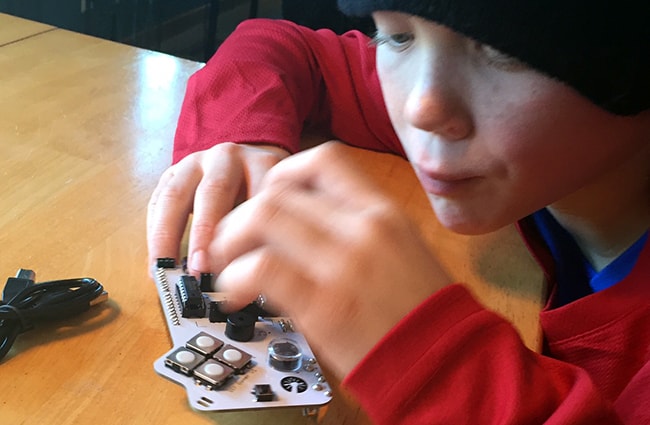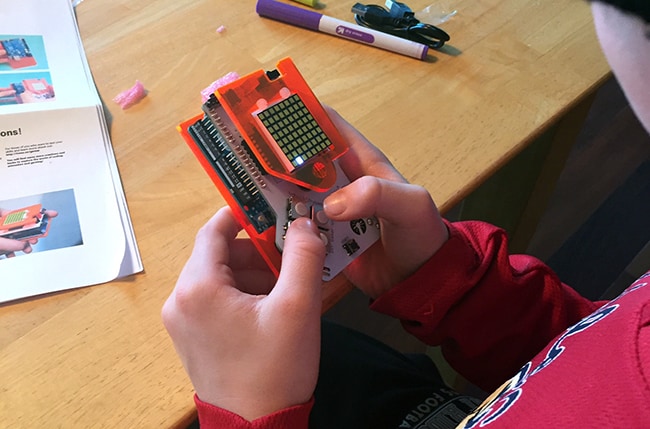Hey Mom, Can We Code This Weekend?

I was asked this by our eight year old son, Luke, just a few days ago. What prompted it? He got to make a device upon which he could also game, and would eventually code.
Lindsey Own recently offered a challenge to bring making into the hour of code. Luke and I got to do exactly that, thanks to the DIY kits offered by Technology Will Save Us, a group that is powering maker ed in the UK and beyond.
What follows is a reflection on the experiences we have shared by combining making and coding…with a touch of gaming thrown in there.
 The Background
The Background
Technology Will Save Us (TWSU) offers a variety of DIY Kits , including one where students can make their own handheld console, play on it, and then code it.
The BBC is so enthralled with the promise of these kits, that they are ensuring every 12 year old in the UK will build one, and they are working with Technology Will Save Us to make it happen.
We first learned about TWSU from Laurie Forcier and Nathan Martin in Pearson London’s Office of the Chief Education Advisor and were excited to check it out.
The Theory: Connect Making, Gaming, and Coding Processes
The theory behind the TWSU kits is that they will inspire and develop makers and coders by including stages of making, playing, learning, and inventing (through coding). As an organization, TWSU is “dedicated to instigating 21st century learning around the kitchen table and in the classroom.”
We took the kitchen table approach. While the idea seemed plausible enough in theory, it proved to be even more compelling in practice.
The Making Process
Luke took on the DIY Gamer Kit, which allowed him to build his own handheld games console (with a flappy bird-like game pre-loaded) on which he could later code and invent his own games.
Through the maker process, we were able to combine kinesthetic and linguistic pieces. As Luke touched, felt and assembled these pieces, he learned what the term meant and about the functionality.
Understanding the language of hardware through making undoubtedly helps provide context as students learn the languages of software through coding.
Here are just a few of the words he learned and the pieces he touched:
- Circuit board – a sheet or platform used for mounting and interconnecting components in electronic equipment
- Light Dependent Resistor (LDR) – a light-controlled variable resistor (also called a photocell)
- Integrated Circuit (IC) – the “brains” of the device.
- Dual-in-Line (DIL) Sockets – designed to protect the Integrated Circuit
- Buttons – allows fingers to send signals to make the game mode
- Power Switch – turns game on and off (nice to have some power switch)
- Infrared Receiver -allows multi player functionality like peripheral vision
It helped to use a few familiar analogies like “the DIL sockets protect the brains of the computer just like a helmet protects the brains of a football player.”
When I asked Luke his favorite part of the process, he said it was when he inserted the 9V battery because it “started to light up and work.”
The Gaming Process
Once the maker phase was completed and the 9V battery was in, he was rewarded with the opportunity to play a couple of pre-loaded games. It was at this point in the process when his older brother declared, “I want my own kit to make.”
The opportunity to play the games snake and icebreaker not only engaged Luke, but also provided a walk down memory lane as I remembered a similar game I played on our family’s first Odyssey video game back in the late 70s (yep, that dates me).
The chance to play games helped develop a sense of ownership and kept Luke coming back to the device.
The Coding Process
As Luke participates in “Hour of Code” activities this week, he sees them not just as something else to do at home and school, but as something to prepare him for the next step of his gamer kit.
In fact, as I write, Luke is alongside me using Hour of Code resources on Code.org. He exclaimed, “I just wrote 8 lines of code – hip, hip, hooray!” and then, “Mom, can you believe I used math to code?”
He will soon be able to code on the TWSU console which is controlled by the open source platform, Arduino. Luke will be able to download and learn to use the software and access a helpful library of code, cheat sheets and how to videos to create and invent their own games.
Teachers and Parents Can Help
Whether you are a teacher, parent, neither or both, there are many opportunities to tie these pieces together. Teacher Kathy Lutes, at New Life Academy aims to introduce her students to JavaScript, Pearls, Scratch, and other computer languages because she sees that “there is no job or project in the world that does not use computer programming in some shape or form.”
If you choose the Technology Will Save Us DIY kits or the myriad resources available for students to make, game and code, there definitely is power in connecting the various processes so that it’s less about “one and done” and more about fitting the pieces together (literally and figuratively).
The answer to Luke’s question? “Yes, we can code this weekend.”
Read more:
- 10 Coding & Computer Science Blogs to Bookmark
- Technology Will Save Us is Powering Maker Ed in the UK
Stay in-the-know with all things EdTech and innovations in learning by signing up to receive the weekly Smart Update. This post includes mentions of a Getting Smart partner. For a full list of partners, affiliate organizations and all other disclosures please see our Partner page.









0 Comments
Leave a Comment
Your email address will not be published. All fields are required.